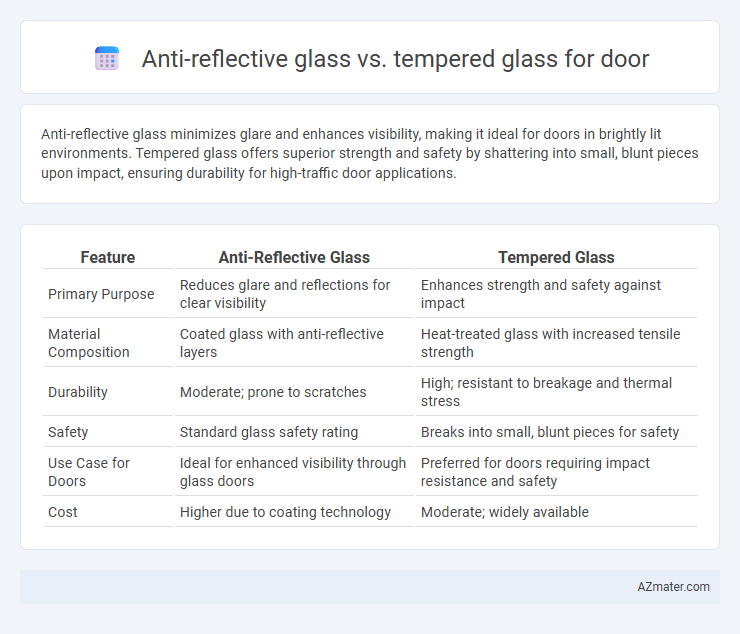Anti-reflective glass minimizes glare and enhances visibility, making it ideal for doors in brightly lit environments. Tempered glass offers superior strength and safety by shattering into small, blunt pieces upon impact, ensuring durability for high-traffic door applications.
Table of Comparison
| Feature | Anti-Reflective Glass | Tempered Glass |
|---|---|---|
| Primary Purpose | Reduces glare and reflections for clear visibility | Enhances strength and safety against impact |
| Material Composition | Coated glass with anti-reflective layers | Heat-treated glass with increased tensile strength |
| Durability | Moderate; prone to scratches | High; resistant to breakage and thermal stress |
| Safety | Standard glass safety rating | Breaks into small, blunt pieces for safety |
| Use Case for Doors | Ideal for enhanced visibility through glass doors | Preferred for doors requiring impact resistance and safety |
| Cost | Higher due to coating technology | Moderate; widely available |
Introduction to Door Glass Types
Anti-reflective glass for doors enhances visibility by minimizing glare and reflections, making it ideal for spaces requiring clear sightlines and aesthetic appeal. Tempered glass offers superior strength and safety, as it shatters into small, blunt pieces rather than sharp shards, making it a preferred choice for entry doors subjected to impact. Both types serve specific functional and safety needs, with anti-reflective glass focusing on visual clarity and tempered glass prioritizing durability and protection.
What is Anti-Reflective Glass?
Anti-reflective glass is specially coated to reduce glare and reflections, enhancing visibility and clarity through the glass surface. This type of glass is ideal for doors in environments where minimizing light distortion and maximizing transparency are critical, such as offices and retail stores. Compared to tempered glass, which is designed primarily for strength and safety through heat treatment, anti-reflective glass prioritizes optical performance.
What is Tempered Glass?
Tempered glass is a type of safety glass processed by controlled thermal or chemical treatments to increase its strength compared to normal glass. This glass is designed to shatter into small, blunt pieces rather than sharp shards, enhancing safety for door applications. Its durability and resistance to impact make tempered glass ideal for doors in both residential and commercial settings.
Key Differences Between Anti-Reflective and Tempered Glass
Anti-reflective glass minimizes glare and enhances visibility by reducing surface reflections, making it ideal for doors where clear sightlines are crucial; tempered glass, on the other hand, offers superior strength and safety through heat treatment, resisting impact and shattering into small, less harmful pieces. The key differences lie in functionality: anti-reflective glass improves optical clarity and aesthetics, while tempered glass prioritizes durability and safety performance. Choosing between the two depends on specific door requirements such as visibility needs versus impact resistance and safety standards.
Durability and Safety Comparison
Tempered glass offers superior durability for doors due to its heat treatment process, which increases strength and causes it to shatter into small, blunt pieces upon impact, enhancing safety. Anti-reflective glass, while providing clear visibility and reducing glare, lacks the same impact resistance and is more prone to breakage under stress. For high-traffic or security-sensitive door applications, tempered glass is the preferred choice because it combines robustness with safer breakage patterns.
Light Transmission and Visibility
Anti-reflective glass offers superior light transmission by minimizing surface reflections, enhancing natural daylight and improving visibility through doors. Tempered glass provides strength and safety benefits but generally has higher reflectivity, potentially reducing clarity and light passage. Choosing anti-reflective glass is ideal for maximizing transparency and visual comfort in door applications.
Aesthetic Appeal for Doors
Anti-reflective glass enhances door aesthetics by minimizing glare and reflections, offering a clear and pristine view that highlights interior design elements. Tempered glass provides a sleek, modern look with added strength and safety, complementing contemporary door styles while ensuring durability. Choosing between the two depends on whether clarity or toughness is prioritized for the door's visual appeal.
Cost Analysis: Anti-Reflective vs Tempered Glass
Anti-reflective glass generally incurs higher costs than tempered glass due to specialized coatings that reduce glare and improve visibility, making it a premium choice for doors in commercial and high-end residential projects. Tempered glass, known for its enhanced strength and safety features, offers a more cost-effective solution with lower manufacturing expenses and widespread availability. Evaluating project budgets, tempered glass provides significant savings, while anti-reflective glass justifies its price through superior optical performance and aesthetic appeal.
Best Use Cases for Each Glass Type
Anti-reflective glass is ideal for doors in settings requiring maximum visibility and minimal glare, such as office entrances and retail storefronts, enhancing transparency and aesthetics. Tempered glass provides superior strength and safety, making it best suited for high-traffic areas, commercial buildings, and residential doors where impact resistance and shatter protection are critical. Selecting between anti-reflective and tempered glass depends on prioritizing either optical clarity or durability for specific door applications.
Choosing the Right Glass for Your Door
Choosing the right glass for your door depends on factors like safety, clarity, and aesthetic appeal. Anti-reflective glass reduces glare and enhances visibility, making it ideal for doors in spaces with bright lighting or outdoor views. Tempered glass offers superior strength and safety by shattering into small, less harmful pieces, perfect for high-traffic or impact-prone areas requiring durability and security.

Infographic: Anti-reflective glass vs Tempered glass for Door
 azmater.com
azmater.com